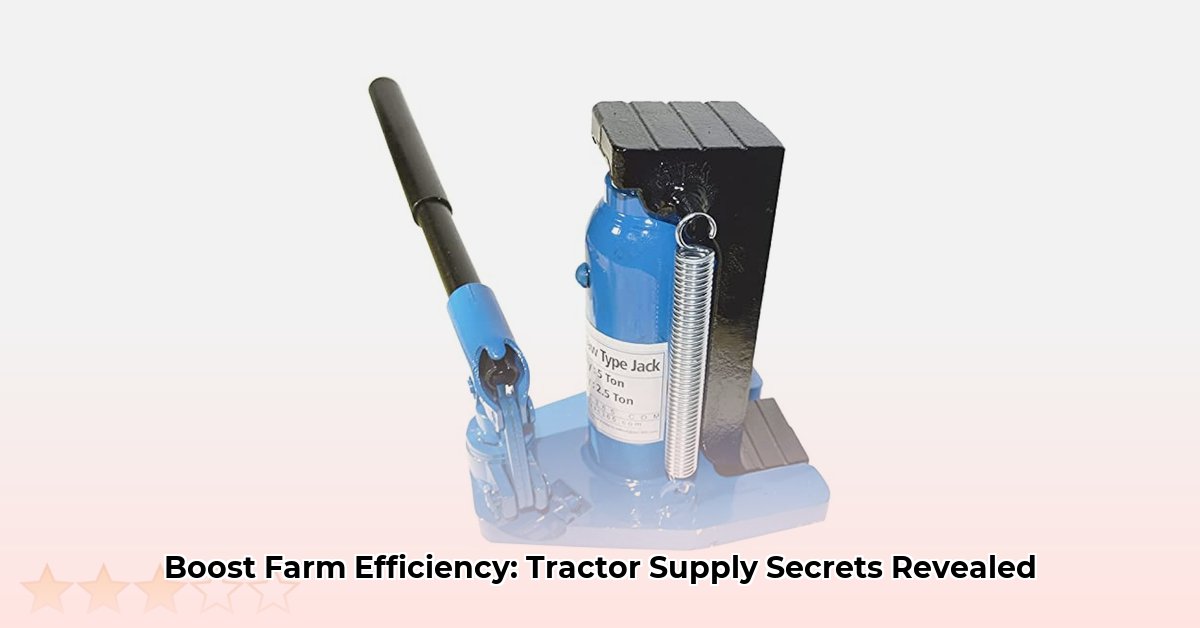
Bottle Jacks: Essential Tools for Modern Farming
Farming demands efficiency, and sometimes, the simplest tools make the biggest difference. A sturdy bottle jack, readily available at Tractor Supply, is one such unsung hero, quietly boosting farm productivity and saving valuable time and labor. But choosing the right jack, and using it effectively, requires some understanding. This guide outlines the key factors to consider when selecting and utilizing a bottle jack to maximize its benefits and ensure safe operation on your farm.
Isn't it frustrating when a simple repair turns into a major ordeal? A reliable bottle jack can transform these frustrating moments into efficient solutions. But with so many options available, choosing the right one can feel overwhelming.
Selecting the Right Bottle Jack: A Step-by-Step Guide
Before heading to Tractor Supply, carefully consider your needs. This will ensure you select a bottle jack perfectly suited for your farm's specific requirements.
Assess Lifting Needs: What's the heaviest piece of equipment you'll need to lift? Don't underestimate the weight; always select a jack with a higher capacity than anticipated for safety. A jack insufficiently rated for the task poses significant safety risks.
Determine Required Lifting Height: How high must you lift your equipment for maintenance or repairs? Consider jacks with adjustable heights or extensions for versatility. A jack unable to achieve the necessary lift is essentially useless.
Prioritize Build Quality: Opt for a jack constructed from durable steel, ideally with a rust-resistant coating. This ensures longevity and dependable performance in varying weather conditions. A flimsy jack is a recipe for accidents.
Safety Features First: Look for essential safety features, such as a reliable release valve to prevent accidental drops and a wide, stable base to prevent tipping. Neglecting safety features endangers both equipment and the operator.
| Feature | Considerations |
|---|---|
| Lifting Capacity | Always choose a capacity exceeding the heaviest load you will lift. |
| Lifting Height | Account for both minimum and maximum height requirements. |
| Construction Material | Durable steel with rust-resistant coating is essential. |
| Safety Features | Release valve and wide base are critical for safe operation. |
“Choosing the right bottle jack is like selecting the right wrench; it's all about having the correct tool for the job,” advises Mark Johnson, a seasoned agricultural engineer with over 20 years of experience at the National Farm Machinery Association. “Safety cannot be overstated; always select equipment exceeding the demands of the task.”
Beyond the Basics: Bottle Jack Applications on the Farm
The versatility of a bottle jack extends far beyond basic repairs:
Tractor Maintenance: Lifting tractors for undercarriage maintenance or tire changes is significantly easier and safer using a bottle jack.
Trailer and Implement Servicing: Repairing trailers, changing tires on farm implements – these tasks are simplified by the jack's power and portability.
General Farm Repairs: From fence mending to minor building maintenance, their adaptability makes them indispensable all-purpose tools.
Maintenance for Optimal Performance
Proper maintenance prolongs the lifespan of your bottle jack and guarantees reliable performance when most needed. Follow these steps:
Routine Cleaning: After each use, carefully clean the jack to remove dirt, debris, and other contaminants.
Regular Lubrication: Apply an appropriate lubricant to all moving parts to ensure smooth operation and prevent wear.
Thorough Inspections: Always inspect the jack for any signs of damage (cracks, bends, corrosion) before usage and promptly replace any damaged components.
Safe Storage: Store your jack in a dry, clean location protected from extreme temperatures and moisture.
“It’s astounding how often simple maintenance is overlooked,” observes Sarah Miller, owner of Miller's Farm and a strong advocate for sustainable farming practices. “Proper maintenance is a small investment that significantly increases the lifespan and safety of equipment.”
Calculating the ROI of Precision Irrigation
While a bottle jack represents a minor investment, larger infrastructure upgrades, like precision irrigation systems, require extensive planning and careful financial evaluation to gauge return on investment (ROI). Here's a breakdown of how to determine the long-term ROI:
Quantify Increased Yield: Carefully calculate the projected increase in crop yield resulting from the more efficient water management provided by the precision system.
Project Revenue Growth: Multiply the increased yield by the current market price of your crop to estimate the potential revenue increase.
Evaluate Water Savings: Determine the water savings and translate those into reduced water bills and associated expenses.
Assess Labor Cost Reductions: Quantify the labor savings resulting from automated irrigation and monitoring.
Factor in Ongoing Costs: Account for maintenance, repairs, energy consumption, software updates, and service contracts.
Calculate Net Benefits: Subtract the total costs (initial investment and ongoing expenses) from the total returns (increased revenue, water savings, labor cost reductions) accumulated across the system's lifespan (e.g. 5 or 10 years).
Determine Net Present Value: Account for the time value of money and discount future cash flows to their present value utilizing online financial calculation tools.
Calculate ROI: Divide your net benefits (present value) by the initial investment to determine the ROI percentage.
Accurate ROI calculations are crucial for making sound investments that support continued farm profitability and long-term sustainability. Effective planning and data analysis are instrumental in successfully implementing precision irrigation systems.